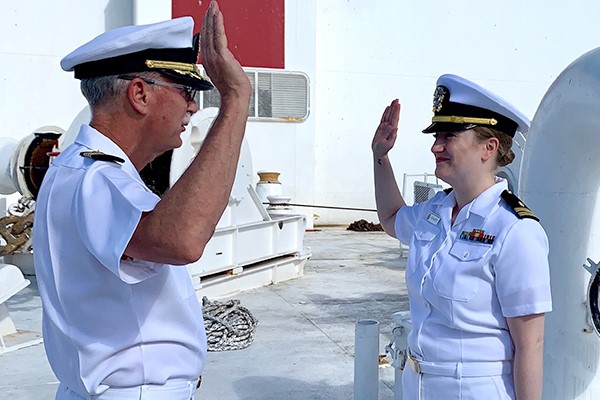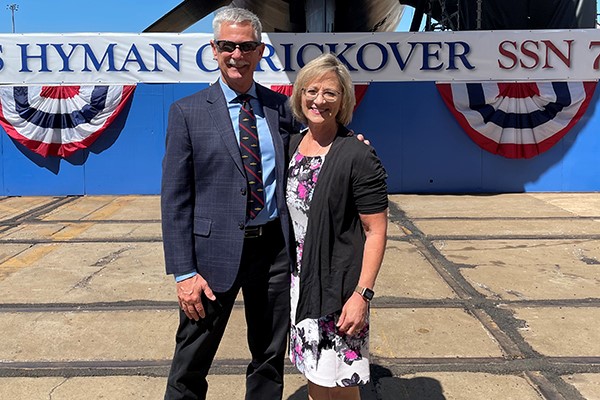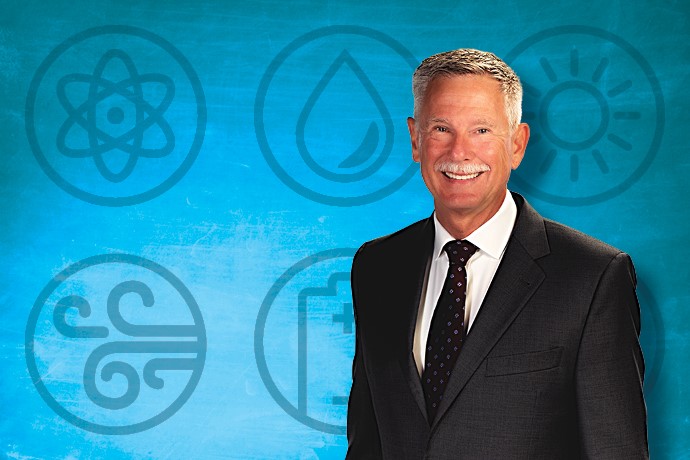Bob Schuetz never imagined a career with Energy Northwest.
It was 2012, and Schuetz was only four years into his civilian nuclear career with the Institute of Nuclear Power Operations (INPO). A 28-year veteran and retired Navy captain, Schuetz had promised his wife, Brenda, that they wouldn’t move again after buying a home in Atlanta, Georgia.
As an INPO employee, Schuetz knew he would be required to spend time on reverse-loan to a commercial nuclear power plant. It’s part of INPO’s practices to send employees out to spend one to two years at a facility in order to stay up-to-date on industry practices.
“When INPO told me I was going to do this reverse loan, I started looking at plants around Atlanta where I could come home on the weekend,” he said.
But when then-INPO president Jim Ellis called Schuetz into his office, it was to suggest he consider Columbia Generating Station, the only nuclear plant in the Pacific Northwest – 2,000 miles away from Atlanta.
Schuetz had been a member of the evaluation team that visited Columbia in 2010, and at the time EN was experiencing leadership changes. After struggling to find someone to fill the Maintenance manager position, EN leadership approached INPO for a loanee. INPO thought his familiarity with the plant would make him a good fit.
From loanee to employee
Schuetz's stint at Columbia was scheduled to last 18 months, but after arriving in the Tri-Cities, he found something his life on the East Coast had been missing.
“When you're on a Navy ship, it's like you're family. You spent your time off-duty together. All the spouses are friends. Everybody is watching out for everybody else," Schuetz said. He didn't find that same lifestyle as a civilian. “I didn't have close friends that I worked with and I missed that. But I didn't necessarily know at the time that was what I missed."
When he arrived at Columbia, Mark Reddemann was CEO, and Brad Sawatzke was settling into the chief nuclear officer position. “We had new leaders. And the size of the plant coupled with the Tri-Cities being a smaller community, it felt like a submarine," Schuetz said.
It felt like home.
Schuetz accepted an offer to leave INPO and stay on at Columbia, and his wife joined him in Richland in 2013. He was promoted to plant general manager in 2014 and site vice president in 2018.
In July 2021, Schuetz accepted the position of CEO.
From Navy to nuclear
Schuetz's interest in the Navy was at first a very practical one: As a Navy ROTC student at Rensselaer Polytechnic Institute, the Navy picked up the tuition and the school covered room and board.
“I had no interest in being in the Navy, but I needed a way to pay for school," Schuetz said.
Between his freshman and sophomore years, Schuetz spent the summer aboard the USS Jouett (CG-29) in San Diego, California. There was a nuclear-powered aircraft carrier in the port at the same time and Schuetz was impressed by the technology. He returned to school and declared a major in nuclear engineering.
After graduating in 1980, Schuetz planned to complete the five years he owed the Navy and then leave the service. After completing his nuclear and submarine training, Schuetz was assigned to a ballistic missile submarine. He spent half of his assignment in the shipyard as the refueling officer.
“Submarines aren't really designed to be refueled," Schuetz said. “They only get refueled once or twice. I had a great time doing it."
While his ship was in the shipyard for refueling, Schuetz met his wife, Brenda, and got married. Then the couple welcomed their first of three daughters.
“Now I've got a wife and a tiny baby, and maybe it's not the perfect time for a change in career."
As his time with the Navy progressed, Schuetz traveled all around the U.S., moving 19 times, with every assignment better than the previous. In 2001, he was assigned to U.S. Strategic Command in Omaha, Nebraska, training to be a senior controller. His first day was Sept. 6, 2001.
As the U.S. experienced the Sept. 11 terrorist attacks, Schuetz was in the command center, along with Adm. Jim Ellis and President George W. Bush. After that, part of Schuetz's job with the strategic planning division was to update the U.S. nuclear war plan annually for Bush.
Ellis retired from the Navy in 2004, after which he took on the role as CEO at INPO.
“It's a lesson not to discount any of the relationships you have over the course of your career," Schuetz said. “I think if I had not done a good job for Admiral Ellis, I wouldn't have even known to apply to INPO."

Bob Schuetz promotes his daughter, Lauren, a naval nurse, onboard the USNS Comfort, a hospital ship. (Photos courtesy Bob Schuetz)
From corner office to accessibility
One lesson from the Navy that Schuetz wants to bring to his role as CEO is the value of informal chain of command, which he learned from regular late-night walks while captain of the USS Hyman G. Rickover (SSN 709).
“Once I established the routine, I noticed there would be crew members in the shaft alley, more than there really should be at that time of night. And they always had something to say," Schuetz said. “I realized that if you create the opportunity to listen, people will talk
Schuetz wants employees to find him approachable and to bring their ideas. To accomplish that, Schuetz plans to maintain offices in EN's Richland-based offices, as well as at Columbia.
“I intend to spend time in those offices with an open door and try to find more opportunities for employee engagement," he said. “It's not to micromanage everyone, but just to listen."

Bob Schuetz and his wife, Brenda, attended the christening of the newest USS Hyman G. Rickover in July 2021. Schuetz was captain of the first submarine to bear the name, which was commissioned in 1984.
Rising to the top
During his time at EN, Schuetz has seen the company on an upward trajectory. Columbia Generating Station earned a top rating in 2020 , and the Energy Services & Development (ESD) arm of the agency has continued to bring in new grants and lead the development of new generating assets, including the Horn Rapids Solar, Storage & Training project (HRSST) and partnerships for the Advanced Reactor Development Project (ARDP).
The future is exciting and there's still room for upward momentum.
“We need to be careful to avoid becoming complacent," Schuetz said. “For a while we were able to focus on big gaps that are somewhat obvious, but now the gaps are much smaller. It's the type of issues we may have dismissed in the past because we had bigger fish to fry. We're down to the anchovies now."
He wants to keep the agency focused on growing a culture of continuous improvement, as keeping Columbia running strong enables Energy Northwest to continue to build relationships and find new opportunities.
Schuetz wants to explore other ways to grow the ESD side of the business, including developing 300 acres of new solar near the HRSST, continuing to support electric vehicle infrastructure and exploring grid modernization opportunities.
“We have a great opportunity to help Washington and the Pacific Northwest realize our clean energy goals. It's not going to just happen – we have to make changes in the way the state makes its power," Schuetz said. “We are particularly well-positioned to do that."
